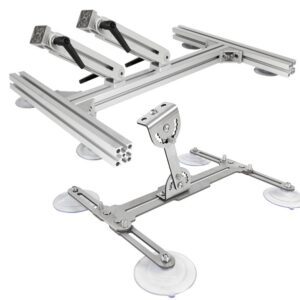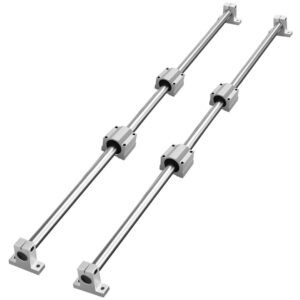The 20mm linear rail has revolutionized the way engineers, machinists, and manufacturers design precise, frictionless motion systems. From CNC machines to 3D printers, linear rails ensure accuracy, load-bearing capacity, and durability. In this article, we’ll dive into the complete world of 20mm linear rails — from their structure and working mechanism to their applications and maintenance. If you’re working in automation, robotics, or precision manufacturing, this guide will help you understand why this component is a cornerstone of modern engineering.
Outline
| Headings and Subheadings | Description |
|---|---|
| Introduction to 20mm Linear Rail | Overview of the concept and purpose |
| Understanding Linear Motion Systems | Explaining the basics of linear motion technology |
| What Makes the 20mm Linear Rail Unique | Size, design, and performance benefits |
| Structure of a 20mm Linear Rail | Components like rail, carriage, and bearings |
| Working Principle of 20mm Linear Rails | Explanation of linear motion and guidance |
| Types of 20mm Linear Rails | Classification based on design and application |
| Key Features of 20mm Linear Rail | Highlighting core advantages |
| Material Composition and Durability | Materials used and their benefits |
| Load Capacity and Performance | Analysis of how load affects movement |
| Installation Guide for 20mm Linear Rail | Step-by-step installation instructions |
| Maintenance Tips for Longevity | Care and upkeep for extended service life |
| Common Problems and Troubleshooting | How to identify and fix common issues |
| 20mm Linear Rail vs. Other Sizes | Comparison with 15mm and 25mm variants |
| Applications in CNC Machinery | How linear rails enhance CNC performance |
| Use in 3D Printing Systems | Benefits in precision printing technology |
| Automation and Robotics Applications | Integration into modern robotic systems |
| Selecting the Right 20mm Linear Rail | Factors to consider before purchasing |
| Cost and Value Analysis | Evaluating cost vs. performance |
| Brands and Manufacturers to Consider | Top global manufacturers in the market |
| Environmental Resistance and Lubrication | Protection from wear and contamination |
| Linear Rail Alignment Techniques | Ensuring accurate installation |
| Role of Bearings in Linear Rails | Understanding bearing performance |
| Safety Considerations | Safe usage and maintenance practices |
| Future Trends in Linear Rail Technology | Innovations in linear motion engineering |
| Final Thoughts on 20mm Linear Rail | Summary of benefits and future outlook |
| FAQs | Common questions about 20mm linear rails |
Introduction to 20mm Linear Rail
The 20mm linear rail represents one of the most balanced and widely used sizes in precision motion systems. Designed to provide smooth linear movement, it’s ideal for machinery that requires accuracy under load. Whether used in industrial robotics, medical equipment, or CNC routers, this rail size offers an excellent balance between rigidity, performance, and space efficiency.
Unlike simple sliding mechanisms, a 20mm linear rail incorporates rolling elements that minimize friction and improve efficiency. Engineers prefer it due to its compact size, which still supports substantial load capacities — making it suitable for both light and heavy-duty applications.
Understanding Linear Motion Systems
Linear motion systems allow controlled movement in one direction. They typically consist of a rail and a moving block (carriage) that slides along it. These systems are crucial in applications demanding precision — from laboratory automation to aerospace machinery.
Linear rails outperform plain bearing systems by offering minimal resistance and superior repeatability. This ensures consistent performance even under dynamic conditions.
What Makes the 20mm Linear Rail Unique
The 20mm dimension isn’t arbitrary. It signifies the rail’s width — a perfect midpoint between compact 15mm rails and heavy-duty 25mm ones. This size delivers a unique blend of stiffness, load capacity, and ease of integration, fitting seamlessly into a broad range of mechanical setups.
Its compact form allows for efficient use of space without sacrificing performance. Additionally, the standardization of 20mm rails across global manufacturers ensures interchangeability, simplifying replacement and upgrading processes.
Structure of a 20mm Linear Rail
A 20mm linear rail system typically consists of:
Hardened steel rail: Provides the track for linear movement.
Carriage (block): Houses the rolling elements and supports the load.
Recirculating ball bearings: Enable frictionless motion.
End caps and seals: Prevent debris entry and retain lubrication.
The precision-ground surface of the rail ensures that the carriage maintains exact positioning, vital in applications like semiconductor assembly or laser cutting.
Working Principle of 20mm Linear Rails
These rails function on the principle of rolling contact, not sliding contact. When the carriage moves, rows of steel balls circulate within raceways between the rail and block. This rolling motion minimizes friction, enabling high-speed, smooth, and accurate linear travel.
The system’s accuracy can reach up to micron-level precision, depending on the manufacturing tolerance and mounting surface quality.
Types of 20mm Linear Rails
Common types include:
Square (profiled) rails: Offer high rigidity and accuracy.
Round rails: Easier to mount but slightly less rigid.
Miniature rails: Compact variants used in micro-mechanical applications.
Profiled 20mm linear rails are most popular for industrial-grade projects because of their superior load-handling and alignment accuracy.
Key Features of 20mm Linear Rail
Some standout characteristics include:
High load capacity despite compact size.
Smooth, silent operation.
Excellent resistance to corrosion and deformation.
Long operational life under continuous motion.
Simple replacement and compatibility with major brands.
These features collectively make the 20mm linear rail a reliable choice for engineers seeking long-term performance.
Material Composition and Durability
Most 20mm linear rails are made of high-carbon steel or stainless steel, sometimes coated with nickel or chrome plating for enhanced corrosion resistance. Carriages often incorporate engineering plastics for seals and retainers, balancing strength with lightness.
Durability depends on both material and maintenance. A properly maintained rail can function flawlessly for over a decade, even in demanding environments.
Load Capacity and Performance
The 20mm size supports significant loads — both radial and moment loads. Depending on brand and type, it can bear loads ranging from 2,000 N to 10,000 N or more. Such strength makes it suitable for CNC spindles, robotic arms, and automated inspection systems.
Performance also depends on precision class — standard, high, or ultra-precision — each offering different tolerances.
Installation Guide for 20mm Linear Rail
Installing a 20mm linear rail involves:
Preparing a flat, clean mounting surface.
Aligning the rail precisely using dowel pins or alignment bars.
Securing with evenly torqued bolts.
Mounting the carriage and checking for smooth movement.
Applying recommended lubrication.
Even a minor misalignment can degrade performance or shorten lifespan, so precise installation is critical.
Maintenance Tips for Longevity
To keep your rail running like new:
Clean the rail regularly with lint-free cloths.
Re-lubricate according to manufacturer recommendations.
Protect from dust and coolant contamination.
Avoid overloading or unbalanced forces.
A well-maintained 20mm linear rail ensures consistent precision and prevents costly downtime.
Common Problems and Troubleshooting
Some typical issues include:
Noise or vibration: Usually caused by contamination or misalignment.
Uneven movement: May result from insufficient lubrication.
Wear marks: Indicate overloading or poor installation.
Routine inspection helps identify such issues early, saving time and repair costs.
20mm Linear Rail vs. Other Sizes
Compared to 15mm rails, the 20mm version offers greater rigidity and load-bearing, while being lighter and easier to handle than the 25mm. It’s the sweet spot for most applications — balancing weight, precision, and affordability.
Applications in CNC Machinery
CNC routers and mills rely on 20mm linear rails for spindle movement and table positioning. The smooth motion ensures perfect cuts and repeatable accuracy, even during high-speed operations. It’s the backbone of precision machining.
Use in 3D Printing Systems
In 3D printers, these rails enable consistent layer alignment and smooth head movement. This ensures high-quality prints with minimal vibration or backlash — a crucial factor for fine detail production.
Automation and Robotics Applications
Automation systems demand precise, repeatable motion. From pick-and-place robots to conveyor modules, 20mm linear rails provide dependable guidance under dynamic load conditions.
Selecting the Right 20mm Linear Rail
When choosing, consider:
Load capacity
Rail length and stroke
Environment (dust, humidity, temperature)
Speed requirements
Brand and warranty
These factors determine how well your system performs under long-term operation.
Cost and Value Analysis
While prices vary by brand, a 20mm linear rail set typically ranges between $50–$200. Although initially more expensive than plain bearings, the long-term accuracy and lifespan justify the investment.
Brands and Manufacturers to Consider
Reputable names include THK, Hiwin, NSK, Bosch Rexroth, and Misumi. Each offers unique product lines suited for different budgets and precision levels.
Environmental Resistance and Lubrication
Rails in humid or dusty settings should feature anti-corrosion coatings and sealing systems. Regular lubrication prevents metal-on-metal contact, ensuring smooth motion even under harsh conditions.
Linear Rail Alignment Techniques
Alignment ensures optimal performance. Use a dial indicator to check rail straightness, and fasten bolts gradually from the center outward to prevent stress deformation.
Role of Bearings in Linear Rails
The rolling elements — usually precision-ground steel balls — are the heroes behind smooth linear travel. Their circular motion reduces energy loss and enhances efficiency, ensuring a nearly frictionless glide.
Safety Considerations
Always wear protective gloves when handling rails, as edges are sharp. Disconnect machinery before servicing, and store rails in dry, flat surfaces to prevent rust or bending.
Future Trends in Linear Rail Technology
Emerging trends include self-lubricating systems, composite materials, and smart sensors for real-time wear monitoring — bringing Industry 4.0 intelligence to mechanical motion systems.
Final Thoughts on 20mm Linear Rail
The 20mm linear rail stands out as a benchmark in precision engineering. Its versatility, reliability, and performance make it indispensable across industries. As manufacturing evolves, these rails will continue to play a vital role in bridging mechanical motion with digital precision.
FAQs
What is the load capacity of a 20mm linear rail?
Typically between 2,000 N and 10,000 N, depending on manufacturer and model.
Can I use a 20mm linear rail in a 3D printer?
Yes, it provides superior stability and precision for high-quality printing.
How often should I lubricate my linear rail?
Every 100–200 operating hours, though this depends on environmental conditions.
Is stainless steel better than carbon steel for rails?
Stainless steel offers better corrosion resistance, ideal for humid or cleanroom environments.
Can I cut a 20mm linear rail to fit my setup?
Yes, but cutting should be performed using precision tools to avoid damage.
Why does my linear rail make noise during movement?
Likely due to contamination, misalignment, or insufficient lubrication.




